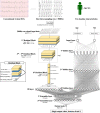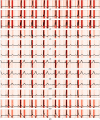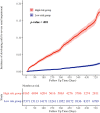Artificial intelligence assessment for early detection and prediction of renal impairment using electrocardiography
- PMID: 35403974
- PMCID: PMC9463260
- DOI: 10.1007/s11255-022-03165-w
Artificial intelligence assessment for early detection and prediction of renal impairment using electrocardiography
Abstract
Purpose: Although renal failure is a major healthcare burden globally and the cornerstone for preventing its irreversible progression is an early diagnosis, an adequate and noninvasive tool to screen renal impairment (RI) reliably and economically does not exist. We developed an interpretable deep learning model (DLM) using electrocardiography (ECG) and validated its performance.
Methods: This retrospective cohort study included two hospitals. We included 115,361 patients who had at least one ECG taken with an estimated glomerular filtration rate measurement within 30 min of the index ECG. A DLM was developed using 96,549 ECGs of 55,222 patients. The internal validation included 22,949 ECGs of 22,949 patients. Furthermore, we conducted an external validation with 37,190 ECGs of 37,190 patients from another hospital. The endpoint was to detect a moderate to severe RI (estimated glomerular filtration rate < 45 ml/min/1.73m2).
Results: The area under the receiver operating characteristic curve (AUC) of a DLM using a 12-lead ECG for detecting RI during the internal and external validation was 0.858 (95% confidence interval 0.851-0.866) and 0.906 (0.900-0.912), respectively. In the initial evaluation of 25,536 individuals without RI patients whose DLM was defined as having a higher risk had a significantly higher chance of developing RI than those in the low-risk group (17.2% vs. 2.4%, p < 0.001). The sensitivity map indicated that the DLM focused on the QRS complex and T-wave for detecting RI.
Conclusion: The DLM demonstrated high performance for RI detection and prediction using 12-, 6-, single-lead ECGs.
Keywords: Artificial intelligence; Deep learning; Electrocardiography; Renal insufficiency.
© 2022. The Author(s).
Conflict of interest statement
KHK, SYL, and BHO declare that they have no competing interests. JK and JP are co-founder and YYJ, MSJ, YJL, YHC, and JHS are researchers of Medical AI Co., a medical artificial intelligence company. JK and JHB are researchers of Body friend Co. There are no products in development or marketed products to declare. This does not alter our adherence to Journal.
Figures




References
-
- Liyanage T, Ninomiya T, Jha V, Neal B, Patrice HM, Okpechi I, Zhao M, Lv J, Garg AX, Knight J, Rodgers A, Gallagher M, Kotwal S, Cass A, Perkovic V. Worldwide access to treatment for end-stage kidney disease: a systematic review. Lancet. 2015;385:1975–1982. doi: 10.1016/S0140-6736(14)61601-9. - DOI - PubMed
MeSH terms
Grants and funding
LinkOut - more resources
Full Text Sources

